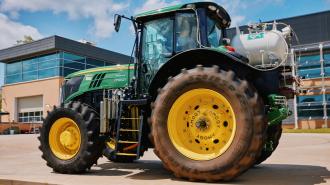A startup founded by four MIT grads has demonstrated the first ammonia-powered tractor — potentially foreshadowing the future of clean energy machines.
Why it matters: Agriculture generates about 10% of the US’s greenhouse gas emissions, and its output is expected to increase in the future as we work to feed a growing population.
Replacing fossil fuel-powered farm equipment with clean alternatives would allow us to significantly reduce the industry’s impact on the climate.
“It does a farm producer no good if the battery runs out in the middle of a 1,000-acre field.”
Scott Miller
The challenge: While batteries are a viable alternative for passenger vehicles, they’re not ideal for tractors and other heavy-duty farm equipment — the higher weight of electric vehicles can lead to short ranges, and long charge times can be a pain for farmers on tight schedules.
“Farm equipment may only get used a few weeks a year [and often for] up to 15 hours a day for many days on end,” Scott Miller, associate dean for industry partnerships at Ohio University’s Russ College of Engineering and Technology, told the Energy News Network. “It does a farm producer no good if the battery runs out in the middle of a 1,000-acre field.”
The ammonia-powered tractor: Lithium-ion batteries aren’t the only option, though — New York-based startup Amogy has now demonstrated the viability of ammonia fuel for heavy-duty equipment, using a mid-sized John Deere tractor.
The company replaced the tractor’s diesel engine with a system that splits liquid ammonia into nitrogen and hydrogen. The hydrogen then powers a 100 kW fuel cell. When it’s time to refuel the ammonia-powered tractor, the process takes about as long as it would with a diesel engine.
“Ammonia is widely available, cheap, and the infrastructure already exists.”
Seonghoon Woo
The benefits: We have seen systems that skip the splitting step and use hydrogen as a fuel, but storing and transporting hydrogen is expensive and complicated.
“The first big advantage of ammonia is that it has been used in different industries for over 100 years, specifically in agriculture where ammonia fertilizer made the food revolution,” Amogy CEO Seonghoon Woo told All About Circuits in January.
“This means that ammonia is widely available, cheap, and the infrastructure already exists,” he continued. “The second advantage of using ammonia is that given its volume and weight, it has the highest energy density among the clean fuels.”
Looking ahead: Ammonia does have its drawbacks. Farmers would need to be careful not to touch or inhale it, and the standard process for making the chemical still produces carbon dioxide.
“Current commonly used industrial methods for producing ammonia, compared to fossil fuel technologies on an energy basis, have a more negative impact on the environment,” wrote Jakub Lasocki of the Warsaw University of Technology in a 2018 assessment.
However, there are “green” methods for making ammonia, and those coupled with Amogy’s system could be a viable option for cleaning up agriculture and more — in the next year, the company expects to demonstrate its tech for Class 8 trucks and shipping vessels, too.
“The Amogy team believes [these demonstrations] will accelerate the adoption of ammonia as the next generation fuel to replace polluting diesel engines with an emission-free solution among transportation industry sectors and investment partners,” said Woo.
We’d love to hear from you! If you have a comment about this article or if you have a tip for a future Freethink story, please email us at [email protected].






